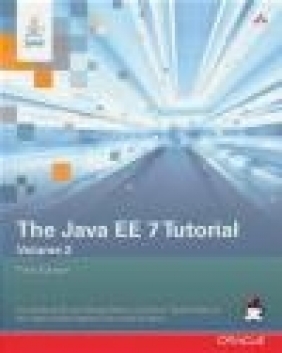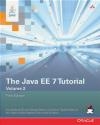The Java EE 7 Tutorial: Volume 2
Chinmayee Srivathsa, William Markito, Eric Jendrock
The Java EE 7 Tutorial: Volume 2
Chinmayee Srivathsa, William Markito, Eric Jendrock
- Producent: Addison Wesley Publishing Company
- Rok produkcji: 2014
- ISBN: 9780321980083
- Ilość stron: 672
- Oprawa: Miękka
Niedostępna
Opis: The Java EE 7 Tutorial: Volume 2 - Chinmayee Srivathsa, William Markito, Eric Jendrock
The Java EE 7 Tutorial: Volume 2, Fifth Edition, is a task-oriented, example-driven guide to developing enterprise applications for the Java Platform, Enterprise Edition 7 (Java EE 7). Written by members of the Java EE documentation team at Oracle, this book provides new and intermediate Java programmers with a deep understanding of the platform. This guide includes descriptions of platform features and provides instructions for using the latest versions of NetBeans IDE and GlassFish Server Open Source Edition. The book introduces Enterprise JavaBeans components, the Java Persistence API, the Java Message Service (JMS) API, Java EE security, transactions, resource adapters, Java EE Interceptors, Batch Applications for the Java Platform, and Concurrency Utilities for Java EE. The book culminates with three case studies that illustrate the use of multiple Java EE 7 APIs.Preface xxxi Part I: Introduction 1 Chapter 1: Overview 3 1.1 Java EE 7 Platform Highlights 4 1.2 Java EE Application Model 5 1.3 Distributed Multitiered Applications 6 1.4 Java EE Containers 13 1.5 Web Services Support 15 1.6 Java EE Application Assembly and Deployment 17 1.7 Development Roles 17 1.8 Java EE 7 APIs 20 1.9 Java EE 7 APIs in the Java Platform, Standard Edition 7 30 1.10 GlassFish Server Tools 33 Chapter 2: Using the Tutorial Examples 35 2.1 Required Software 35 2.2 Starting and Stopping GlassFish Server 39 2.3 Starting the Administration Console 40 2.4 Starting and Stopping the Java DB Server 40 2.5 Building the Examples 41 2.6 Tutorial Example Directory Structure 41 2.7 Java EE 7 Maven Archetypes in the Tutorial 42 2.8 Getting the Latest Updates to the Tutorial 43 2.9 Debugging Java EE Applications 44 Part II: Enterprise Beans 47 Chapter 3: Enterprise Beans 49 3.1 What Is an Enterprise Bean? 49 3.2 What Is a Session Bean? 51 3.3 What Is a Message-Driven Bean? 53 3.4 Accessing Enterprise Beans 55 3.5 The Contents of an Enterprise Bean 62 3.6 Naming Conventions for Enterprise Beans 63 3.7 The Lifecycles of Enterprise Beans 63 3.8 Further Information about Enterprise Beans 66 Chapter 4: Getting Started with Enterprise Beans 67 4.1 Creating the Enterprise Bean 68 4.2 Modifying the Java EE Application 71 Chapter 5: Running the Enterprise Bean Examples 73 5.1 The cart Example 73 5.2 A Singleton Session Bean Example: counter 81 5.3 A Web Service Example: helloservice 89 5.4 Using the Timer Service 92 5.5 Handling Exceptions 104 Chapter 6: Using the Embedded Enterprise Bean Container 105 6.1 Overview of the Embedded Enterprise Bean Container 105 6.2 Developing Embeddable Enterprise Bean Applications 106 6.3 The standalone Example Application 109 Chapter 7: Using Asynchronous Method Invocation in Session Beans 113 7.1 Asynchronous Method Invocation 113 7.2 The async Example Application 116 Part III: Persistence 121 Chapter 8: Introduction to the Java Persistence API 123 8.1 Entities 123 8.2 Entity Inheritance 136 8.3 Managing Entities 141 8.4 Querying Entities 146 8.5 Database Schema Creation 147 8.6 Further Information about Persistence 150 Chapter 9: Running the Persistence Examples 151 9.1 The order Application 151 9.2 The roster Application 165 9.3 The address-book Application 174 Chapter 10: The Java Persistence Query Language 179 10.1 Query Language Terminology 180 10.2 Creating Queries Using the Java Persistence Query Language 180 10.3 Simplified Query Language Syntax 182 10.4 Example Queries 183 10.5 Full Query Language Syntax 189 Chapter 11: Using the Criteria API to Create Queries 215 11.1 Overview of the Criteria and Metamodel APIs 215 11.2 Using the Metamodel API to Model Entity Classes 217 11.3 Using the Criteria API and Metamodel API to Create Basic Typesafe Queries 219 Chapter 12: Creating and Using String-Based Criteria Queries 227 12.1 Overview of String-Based Criteria API Queries 227 12.2 Creating String-Based Queries 228 12.3 Executing String-Based Queries 229 Chapter 13: Controlling Concurrent Access to Entity Data with Locking 231 13.1 Overview of Entity Locking and Concurrency 231 13.2 Lock Modes 233 Chapter 14: Creating Fetch Plans with Entity Graphs 237 14.1 Entity Graph Basics 238 14.2 Using Named Entity Graphs 240 14.3 Using Entity Graphs in Query Operations 241 Chapter 15: Using a Second-Level Cache with Java Persistence API Applications 243 15.1 Overview of the Second-Level Cache 243 15.2 Specifying the Cache Mode Settings to Improve Performance 245 Part IV: Messaging 251 Chapter 16: Java Message Service Concepts 253 16.1 Overview of the JMS API 253 16.2 Basic JMS API Concepts 257 16.3 The JMS API Programming Model 260 16.4 Using Advanced JMS Features 278 16.5 Using the JMS API in Java EE Applications 287 16.6 Further Information about JMS 298 Chapter 17: Java Message Service Examples 299 17.1 Overview of the JMS Examples 300 17.2 Writing Simple JMS Applications 301 17.3 Writing More Advanced JMS Applications 319 17.4 Writing High Performance and Scalable JMS Applications 328 17.5 Sending and Receiving Messages Using a Simple Web Application 332 17.6 Receiving Messages Asynchronously Using a Message-Driven Bean 336 17.7 Sending Messages from a Session Bean to an MDB 341 17.8 Using an Entity to Join Messages from Two MDBs 346 17.9 Using NetBeans IDE to Create JMS Resources 354 Part V: Security 357 Chapter 18: Introduction to Security in the Java EE Platform 359 18.1 Overview of Java EE Security 360 18.2 Security Mechanisms 365 18.3 Securing Containers 369 18.4 Securing GlassFish Server 370 18.5 Working with Realms, Users, Groups, and Roles 371 18.6 Establishing a Secure Connection Using SSL 379 18.7 Further Information about Security 381 Chapter 19: Getting Started Securing Web Applications 383 19.1 Overview of Web Application Security 384 19.2 Securing Web Applications 385 19.3 Using Programmatic Security with Web Applications 395 19.4 Examples: Securing Web Applications 401 Chapter 20: Getting Started Securing Enterprise Applications 411 20.1 Basic Security Tasks for Enterprise Applications 411 20.2 Securing Enterprise Beans 412 20.3 Examples: Securing Enterprise Beans 422 Chapter 21: Java EE Security: Advanced Topics 431 21.1 Working with Digital Certificates 431 21.2 Authentication Mechanisms 436 21.3 Using the JDBC Realm for User Authentication 441 21.4 Securing HTTP Resources 443 21.5 Securing Application Clients 446 21.6 Securing Enterprise Information Systems Applications 448 21.7 Configuring Security Using Deployment Descriptors 451 21.8 Further Information about Advanced Security Topics 453 Part VI: Java EE Supporting Technologies 455 Chapter 22: Transactions 457 22.1 Transactions in Java EE Applications 458 22.2 What Is a Transaction 458 22.3 Container-Managed Transactions 459 22.4 Bean-Managed Transactions 465 22.5 Transaction Timeouts 467 22.6 Updating Multiple Databases 467 22.7 Transactions in Web Components 468 22.8 Further Information about Transactions 469 Chapter 23: Resource Adapters and Contracts 471 23.1 What Is a Resource Adapter? 471 23.2 Metadata Annotations 475 23.3 Common Client Interface 477 23.4 Using Resource Adapters with Contexts and Dependency Injection for Java EE (CDI) 478 23.5 Further Information about Resource Adapters 479 Chapter 24: The Resource Adapter Examples 481 24.1 The trading Example 481 24.2 The traffic Example 488 Chapter 25: Using Java EE Interceptors 497 25.1 Overview of Interceptors 497 25.2 Using Interceptors 499 25.3 The interceptor Example Application 507 Chapter 26: Batch Processing 511 26.1 Introduction to Batch Processing 512 26.2 Batch Processing in Java EE 516 26.3 Simple Use Case 519 26.4 Using the Job Specification Language 523 26.5 Creating Batch Artifacts 533 26.6 Submitting Jobs to the Batch Runtime 539 26.7 Packaging Batch Applications 540 26.8 The webserverlog Example Application 541 26.9 The phonebilling Example Application 548 26.10 Further Information about Batch Processing 557 Chapter 27: Concurrency Utilities for Java EE 559 27.1 Concurrency Basics 559 27.2 Main Components of the Concurrency Utilities 560 27.3 Concurrency and Transactions 561 27.4 Concurrency and Security 562 27.5 The jobs Concurrency Example 562 27.6 The taskcreator Concurrency Example 567 27.7 Further Information about the Concurrency Utilities 570 Part VII: Case Studies 571 Chapter 28: Duke's Bookstore Case Study Example 573 28.1 Design and Architecture of Duke's Bookstore 573 28.2 The Duke's Bookstore Interface 575 28.3 Running the Duke's Bookstore Case Study Application 580 Chapter 29: Duke's Tutoring Case Study Example 583 29.1 Design and Architecture of Duke's Tutoring 583 29.2 Main Interface 585 29.3 Administration Interface 590 29.4 Running the Duke's Tutoring Case Study Application 592 Chapter 30: Duke's Forest Case Study Example 595 30.1 Design and Architecture of Duke's Forest 596 30.2 Building and Deploying the Duke's Forest Case Study Application 610 30.3 Running the Duke's Forest Application 611 Index 615
Szczegóły: The Java EE 7 Tutorial: Volume 2 - Chinmayee Srivathsa, William Markito, Eric Jendrock
Tytuł: The Java EE 7 Tutorial: Volume 2
Autor: Chinmayee Srivathsa, William Markito, Eric Jendrock
Producent: Addison Wesley Publishing Company
ISBN: 9780321980083
Rok produkcji: 2014
Ilość stron: 672
Oprawa: Miękka
Waga: 1.11 kg


























